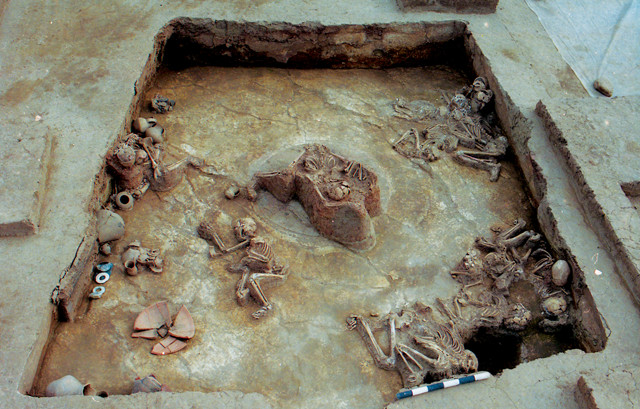
by Kate S. Zalzal Wednesday, December 7, 2016

Fourteen skeletons of victims killed by an earthquake in Qinghai Province, China, some 4,000 years ago. The earthquake may also have triggered a landslide that blocked the Yellow River, eventually leading to a catastrophic outburst flood. Credit: Cai Linhai.
Ancient Chinese texts re-count the story of a great flood on the Yellow River some 4,000 years ago and Emperor Yu’s heroic efforts to dredge and redirect floodwaters, thereby taming the prolonged and catastrophic floodwaters and setting the stage for the agricultural boom that followed. His success is said to have proved a divine mandate for establishing the Xia dynasty, the first in China’s history. But in the absence of geological evidence for such a flood, scholars have long disagreed as to the veracity of the story.
In a new study, scientists from China and the U.S. present evidence that a catastrophic outburst flood did indeed occur in the early second millennium B.C. along the Yellow River in Qinghai Province. Qinglong Wu, a geologist at Peking University in Beijing and lead author of the new paper in Science, and his colleagues found the remains of a landslide, likely triggered by an earthquake, that dammed the Yellow River, as well as lake-bottom and outburst-flood sediments.
Wu and his team mapped the deposits; they estimated that peak flow during the flood was more than 500 times above average and that the outburst flood could have easily travelled more than 2,000 kilometers downstream. Radiocarbon dating of the deposits, along with dated archaeological artifacts downstream, including human remains, puts the flood at about 1920 B.C.
If this outburst flood is the basis of Yu’s Great Flood, it places the beginning of the Xia dynasty at about 1900 B.C., several centuries later than traditionally thought and more in line with other archaeological data. This date coincides with the major sociopolitical transition from the Neolithic Age to the Bronze Age in the region as well. Wu and his co-authors write that these major natural and sociopolitical events “may not simply be coincidence but rather an illustration of a profound and complicated cultural response to an extreme natural disaster.”
© 2008-2021. All rights reserved. Any copying, redistribution or retransmission of any of the contents of this service without the expressed written permission of the American Geosciences Institute is expressly prohibited. Click here for all copyright requests.